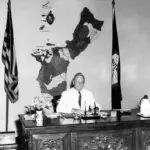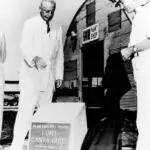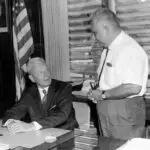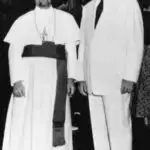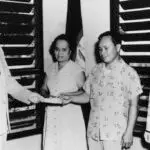Governor Ford Quint Elvidge
Table of Contents
Share This
Governor of Guam 1953-1956
Ford Quint Elvidge (1892 – 1980) was the second appointed civilian governor of Guam. He was appointed by President Dwight D. Eisenhower in 1953 and remained in office until May 1956. He was assisted by Lieutenant Governor Randall Herman who had worked with the previous governor, Carlton Skinner. Elvidge was a Republican attorney from Seattle, Washington, and a Freemason, whose years as governor were marked with tension as the island struggled to transition from military to permanent civilian government.
Early life
Born 30 November 1892 in Oakland, California, Ford Elvidge spent his early years in Oakland before moving with his parents and brother in 1911 to Vancouver, British Columbia, Canada. Uninterested in joining the Canadian bar, he moved to Seattle in 1916 and entered the University of Washington. He was studying law there when the United States entered World War I in 1917. Elvidge enlisted in the US Army Reserve Corps. He was commissioned and sent to training as part of the US Medical Corps, making it as far as Camp Mills in New York before the armistice ending the war went into effect. Returning from Camp Mills, Elvidge married Anita Emily Miller in 1918. He was admitted to the Washington State Bar in 1919 and began working with the law offices of Tucker and Hyland in Seattle. Eventually he founded Elvidge, Watt, Veblen & Tewell, remaining there until his retirement in 1974 as head of the firm.
Elvidge had a long history of involvement in Republican politics. Although he was not a supporter of President Eisenhower he was a supporter of Republican policy and office holders. The year before his appointment, Elvidge made an unsuccessful bid for the Republican Party nomination for lieutenant governor of Washington State.
In a 1976 interview for the Dwight D. Eisenhower Library, Elvidge recounted his appointment as Guam’s second civilian governor. At the time, Douglas McKay of Oregon was the Secretary of Interior after Eisenhower’s inauguration in January 1953. The office of governor of Guam had just become vacant. Although Elvidge did not know McKay well, McKay’s assistant was a fellow resident of Seattle named Raymond C. Davis. Davis and Elvidge were good friends and Davis contacted him offering him the position. The offer was a shock, but Davis was insistent, informing Elvidge that “The island was in kind of a mess and Doug McKay had to get the job filled.”
Governor of Guam
Elvidge was offered an annual salary of $13,125 (the $125 was to cover costs for “air mail postage,” he was told), and a new government house. Without really knowing where Guam was or anything else about the island, Elvidge accepted the appointment and he and his wife arrived on island in April 1953. In his inaugural address to a crowd of about 3,500 in the Plaza de España, Elvidge expounded upon his goals and perceived responsibilities to the people of Guam and to the United States government. He stated:
I am here as your Governor…But in acting as your governor, I want you to know that I regard myself as much your chief servant as your chief executive officer. I want, as soon as I can, to learn all I can about your island, its government, your lives and your traditions. Only by so doing can I adequately serve you.
Elvidge noted that the island, although operating under a civilian government, was still largely under military control. Most striking was the Navy’s strict control of entry and exit to and from Guam, requiring security clearance. In fact, Elvidge initially had been denied entry to board the plane headed to Guam to assume his post after he revealed he had no security clearance from the Navy. After some questioning and Elvidge’s assurance that he was, indeed, the newly appointed governor of Guam, he finally was allowed to board the plane.
According to historians Paul Carano and Pedro Sanchez, Elvidge’s administration was defined by a determined effort to reduce government spending and improving the territory’s medical facilities and school system. In addition, the governor tried to encourage the local population to engage in western style commercial agriculture, but this effort was met with little success.
However, Elvidge did have several notable achievements. Using his experience as a lawyer, he was able to negotiate with the naval authorities an agreement to increase power and water allocations for the general public. Elvidge also worked to get Guam included in the Federal National Mortgage Association program, which helped provide funds for new housing or to build additions to existing housing for local residents.
The Elvidge administration also developed an islandwide cleanup program. Upon his arrival on Guam, Elvidge had observed that the island was littered with surplus military materials, abandoned automobile wreckage, piles of dumped trash and other eyesores which presented a potential health hazard. The cleanup campaign focused on education on proper sanitation procedures and village level efforts to remove garbage. In January 1954, Elvidge focused on acquiring over $100,000 worth of surplus military property, including plumbing supplies, heavy equipment, tools and typewriters. Many of these items were used by the government and also by the newly opened vocational school.
Another of Governor Elvidge’s significant achievements was his proposal to convert the newly constructed nursing school building at the Guam Memorial Hospital to a general hospital ward. The nursing school was part of a new hospital complex being constructed in Oka, Tamuning. Elvidge feared that funding would run out during the construction of the hospital due to decreasing tax revenues. Although Elvidge’s plan was initially rejected by the Legislature, eventually by 4 June 1955, a new 6-story, 65,000 square foot structure became a new wing of the permanent Guam Memorial Hospital.
Elvidge also worked toward the reopening of the Guam Museum in the garden house at the grounds of the Plaza de España, forming a Parks, Monuments and Museum Committee to reestablish, equip and operate the museum, as well as conduct studies and restore and preserve important historical landmarks.
Furthermore, during the Elvidge administration, Public Law 42 was passed, which allowed for jury trial in certain cases within the jurisdiction of the newly established District Court of Guam. Cargo handling rates at the Guam Commercial Port were reduced; the installation of a modern, islandwide telephone system was completed, and new schools were built in Inalåhan and Sånta Rita-Sumai.
At the national level, Elvidge traveled to Washington, DC and had discussions with the Department of Interior officials and President Eisenhower regarding progress on Guam. Elvidge desired to clarify how and which federal laws were to be applied to Guam, especially in light of the Organic Act. He also expressed interest in the territory having its own representative in Congress, asserting, “I think Guam should have representation. They are not a large unit, but they are an integrated part of the United States.
Elvidge and his wife were the first official occupants of the newly built Government House on top of San Ramon Hill overlooking Hagåtña. The Elvidge’s developed close relationships with Federal Judge Paul Shriver and his wife Melba, the Commander, Naval Marianas and staff, as well as Bishop Apollinaris Baumgartner, the head of the Roman Catholic Church. Although the governor and the bishop had agreed they would not interfere in each other’s roles, Elvidge did note that Baumgartner had a representative in the Guam Legislature, Fr. Felixberto Flores, who regularly observed the group’s proceedings. Of the few women Elvidge become acquainted with, CHamoru/Chamorro educator Agueda I. Johnston was the most prominent.
According to Carano and Sanchez, Elvidge had a contentious relationship with the Second Guam Legislature who were elected into office in 1953. While the previous governor Carlton Skinner was able to work cooperatively with members of the First Guam Legislature, Elvidge was unable to attain the same level of cooperation. For example, he was criticized for having vetoed over nine pieces of legislation in his first few months in office. That year, the legislature passed 51 public laws and 82 resolutions. One of the bills that Elvidge had vetoed actually made it to the desk of the President of the United States – the first such bill sent to the President for final action. (The bill had proposed that movie censorship be established on Guam. Elvidge objected and President Eisenhower agreed with the governor.)
In addition, the Elvidge administration and several of his appointees were subject to verbal attacks by some of the members of the legislature. Most of their disagreements stemmed from the Republican, conservative governor’s views clashing with the mostly liberal views of the legislature. Frequently, Elvidge was very vocal about his displeasure with the legislature, especially when he did not get his way.
Years later when asked about how he was perceived by the people of Guam, he replied:
I went out there as an appointee of Eisenhower…[who] was looked upon by everybody as a great man and highly respected. And so when I went out there, I was a representative of Eisenhower. So a great deal of the respect for Eisenhower reflected in my favor and I got along very well with them. But that relationship between civilian government and the civilian people was to a certain extent disintegrating as they gained more control. They began to feel their oats, so to speak, and begin to, well, just as the Congress feels it’s more important than the President, so the Guam Legislature began to assume a more important feeling than that awarded to the civilian governor.
Elvidge’s term, though, also was contentious because he did not have a very high opinion of the Chamorro people, infantilizing them by likening them to children who could not or did not know how to take care of themselves. In his interview for the Eisenhower library, he said he believed that the Chamorros were good people but incompetent, and had difficulty handling the challenges of a cash economy and other social issues, such as prostitution and gambling. So, in addition to cleaning up the island of garbage and boonie dogs, Elvidge wanted to remove taxi-dancers.
Elvidge believed the gambling and prostitution problem on Guam was the result of the presence of “taxi-dancers” mostly from the Philippines and Hawaii. Taxi-dancers were women who frequented the dance halls and would be paid to be a man’s dance partner. The large number of Filipino laborers hired for the postwar reconstruction, as well as military personnel, contributed to the increase in popularity of taxi-dancing. The dancing, though, was seen as a cover for prostitution and so Elvidge put a bill to the legislature to ban taxi-dancing. According to Elvidge the legislature sat on the bill for weeks until he asked Bishop Baumgartner to intervene. The bill finally passed, and the taxi-dancers were sent off-island. Elvidge is also remembered for prohibiting all forms of gambling at the Liberation Day festival grounds, saying, “The occasion should be dignified.”
At the end of his term, Elvidge wrote an article published in the 1 December 1956 issue of the Saturday Evening Post entitled “I Ruled Uncle Sam’s Problem Child,” in which he recounted the incident of initially being refused entry into Guam because of the security clearance requirement. He complained of not finding a paradise, but rather, an island plagued by garbage and invasive creatures like toads and African snails. He wrote:
My dream of the tropical life – wearing a white suit, smelling flowers and sitting under palm trees – didn’t survive my first day in office.
But most appalling to local readers was his assertion that “Many Guamanians, once enthusiastic pro-Americans, now bitterly resented statesiders and their influence,” and other references of anti-American/anti-Caucasian sentiments by the people of Guam.
His successor, Governor Richard Barrett Lowe, had to respond to the article after the public uproar it generated on Guam. The editors of the Guam Daily News also printed an editorial piece in response to the scathing, disparaging remarks by Elvidge, calling the former governor a “Disgruntled Ruler,” who “really laments, it seems…that he was not allowed the full reign of dictatorship; that some of the indigenous people whom he wanted to rule had the nerve to talk back to him, to ‘box his ears’ occasionally. He had – and there’s no question about it – a rugged administration. He wanted it that way, he asked for it; and evidently when he couldn’t take any more of it, he quit…And it seems very indecent of the ex-governor to conclude, as he apparently does, that because he wasn’t liked here it follows that Guamanians don’t really like Americans. No American, Guamanian or otherwise, can patriotically like dictatorship or dictators.”
In 1972, Governor Elvidge’s wife Anita published Guam Interlude, a small book which recounted their experiences living on Guam, including their arrival, their residence and servants, and the adjustments to life on a tropical island. Like her husband’s article in the Saturday Evening Post, Guam Interlude highlighted the prevailing perception by “statesiders” of the local population as lazy but good-natured, kind but childlike and naive. Mrs. Elvidge’s concluding paragraph, however, expressed more affection for the people of Guam:
We loved the Island and its people, sweated and worried over their progress. We had striven to please them and advise them. We loved the sunshine, the beautiful beaches, the loyalty and earnestness of the people…But best of all, we appreciate the opportunity that enabled us to have a part in shaping the destiny of an important – though small – segment of the United States of America.
Governor Elvidge died at the age of 87 on 14 July 1980. According to his obituary in the Seattle Times, he had served as a past president of the Seattle Bar Association, the College Club and the University of Washington Law School Alumni Association, and was a former member of the board of the Washington State Bar Association. Elvidge was also a past president of the Seattle chapter of the English-speaking Union and served as legal counsel to the British consul in Seattle. In 1966, Queen Elizabeth II conferred on him the title of honorary commander of the Most Excellent Order of the British Empire. He was an active member of the Washington State Masons where he was a Past Grand Master; he was also a 33rd degree Mason, a past potentate of the Nile Temple and was affiliated with other Masonic bodies. Governor Elvidge and his wife Anita had three children: a son, Robert, and two daughters, Marthanna and Carolyn.
For further reading
Elvidge, Anita M. Guam Interlude. Self-published, 1972.
Fiftieth Anniversary of Guam Organic Act. 106th Congress, 2nd Session, Congressional Record 146, pt. 12: 16627-16630.

